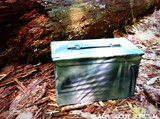Cache Locations

Cache locations will depend on what application you are using it for:
- From work to home
- home to bug out location
- an offsite location with general survival supplies
Why would you need a cache from work to home? If something catastrophic happens and going by vehicle is not an option- what do you do? Do you have enough gear on you or in your EDC bag to get to your house? How far is your house from your work? Can you make it on foot in your current physical condition?
If your within a few miles (walking distance); you may not need a cache. If your over 10 miles, I would highly recommend a cache en route to home. Especially if your having to evade during the commute back. A short hike could turn into days when trying to stay on the move while being undetected.
Getting to your BOL (bug out location) you may encounter hostiles, gas stations may be closed, or your bug out location may be a state or two away. Things like food, water, gas, and ammo may be needed to make it to your Bug Out location.
Another thing to consider will be if its an "onsite" or "offsite" cache. I believe you should have a few of both.
- Onsite-Your residence, safety deposit box, property you own other than your residence, or a storage unit. These are just a few examples. Basically something you own or is in your name to access freely.
- Offsite- Family or friends house, buried or hidden on someone else's property, along the road (home-work/home-BOL), inside a building. Basically something you do not own or have rights to.
Onsite and offsite caches will also be gear dependent and I will also go over that in a future article.
Caches can also be buried, overt, covert, and or camouflaged.
Buried
- The biggest con to this method is that digging is required for placing and retrieving. This means tools may be needed to recover the cache.
- The possibility of the cache being found by someone other than you is unlikely. To prevent metal detection- throw scrap metal around the area.
- You must remember the exact location. Do this by pace counting from a terrain feature like a tree. You can also carve initials with a heart as if some lovers had been there to help you identify the tree. For night time identification you can use glow-in-the-dark tack's as sold in most hunting stores.
Overt
- In plain sight without giving away its true nature.Such as a coffee can in the pantry that contains currency or jewelry. Or something like a pistol stored in a dog food bin.
Covert/Camouflaged (Above Ground)
- Covert or Camouflaged caches have the benefit of being easy to find/retrieve.
- The problem with them is that they are easier to find/retrieve for other individuals as well.
- These should be considered for more short term caches and not to be in place for an extended amount of time.
- Can be camouflaged with paint (similar to mine above) which will also protect if from the elements. A camouflaged ammo can could be hidden in a low hanging bush and will be very hard to detect in a dense wilderness environment.
Onsite caches can be buried on your property or under your house (if you have a crawl space). They can be hidden within your house in an overt/in-plain-sight manner. I will discuss this further in the next article about cache containers. Onsite caches are easy to recover and can be recovered at any time because your the owner of the location.
Offsite poses a few problems such as discreetly placing the cache so that no one sees and steals your cache. They can be compromised at anytime, leaving you without any supplies in an emergency. You must remember the exact location of the cache. There is also the possibility that the location changes- i.e. structure is built over your cache, storm destroys or makes it impossible to retrieve your cache, or your cache container fails and destroys your contents.
These are some things to consider when thinking about where to place your cache. Utilizing a mix of the above locations will give you an advantage over just burying a few caches along your Bug Out Route. Spread them around and you will be better prepared. We will continue this series discussing other ideas surrounding caches. Also check out our YouTube for a video series on this subject.
